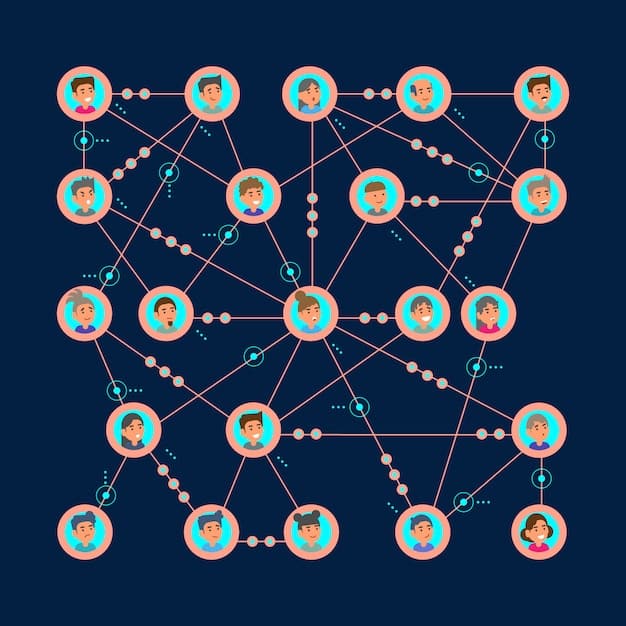Secure $10,000 Grants for Community Action Projects in 2025

Securing a $10,000 grant for community action projects in 2025 requires a strategic approach focused on compelling proposals, understanding funder priorities, demonstrating community impact, and meticulous financial planning to effectively bridge funding gaps and maximize project reach.
In 2025, the landscape for community action projects seeking funding is both competitive and opportunity-rich. Understanding how can community action projects secure $10,000 grants in 2025 is crucial for organizations aiming to make a tangible difference with limited budgets. This guide delves into actionable strategies, from identifying suitable funders to crafting winning proposals and demonstrating impactful results, ensuring your project stands out in the quest for vital financial support.
Understanding the Funding Landscape for 2025
The year 2025 presents a unique set of challenges and opportunities for community action projects seeking grants. Economic shifts, evolving social priorities, and technological advancements all influence where grant money is directed. To successfully secure funding, especially for amounts like $10,000, projects must first grasp the current philanthropic environment and identify potential avenues for support.
Philanthropic organizations, corporate foundations, and government agencies are constantly refining their funding priorities based on prevailing societal needs and strategic objectives. This demands that community projects stay agile, adapting their narratives and methodologies to align with these changing focuses. A clear understanding of what funders are looking for is the first step toward a successful grant application.
Identifying Key Funder Priorities
In 2025, funders are increasingly prioritizing projects that demonstrate measurable impact, sustainability, and innovative solutions to pressing community issues. They are also keenly interested in initiatives that promote equity, diversity, and inclusion. Researching the mission statements and past grant recipients of potential funders is essential before even beginning the application process.
- Measurable Impact: Funders want to see clear metrics and evaluation plans.
- Sustainability: Projects should outline how they will continue beyond the grant period.
- Innovation: Unique approaches to long-standing problems are highly valued.
- Equity and Inclusion: Projects addressing systemic disparities are often prioritized.
Furthermore, many funders are moving towards supporting projects that leverage technology for greater efficiency and reach, or those that foster strong community partnerships. Understanding these nuances can help tailor your project proposal to resonate more effectively with different grant-making bodies.
Navigating Geographic and Thematic Funding
While some grants are broad, many are geographically or thematically restricted. For community action projects in the US, this means looking for state-specific or city-specific grants, as well as those focused on particular issues like environmental protection, youth development, or public health. The $10,000 grant level is often ideal for local foundations or corporate giving programs with a strong community focus.
Thorough research into community foundations, local businesses with philanthropic arms, and even civic organizations can reveal numerous opportunities that align perfectly with smaller-scale project needs. These entities often value direct community engagement and grassroots initiatives, which are hallmarks of effective community action.
In conclusion, the 2025 funding landscape demands diligence and strategic alignment. Projects that invest time in understanding funder priorities and tailor their approach accordingly will naturally position themselves for success in securing modest yet impactful grants.
Crafting a Compelling Grant Proposal
A well-structured and persuasive grant proposal is the cornerstone of securing any funding, especially for the $10,000 mark. It often serves as the project’s primary advocate, speaking directly to the funder’s objectives and demonstrating why their investment will yield significant returns. In 2025, proposals need to be concise, data-driven, and story-rich, balancing factual solidity with an engaging narrative.
Funders are inundated with applications, so standing out requires more than just meeting the basic criteria. It requires delivering a compelling case that highlights the unique value and transformative potential of your community action project. Every section, from the executive summary to the budget, must contribute to this overarching narrative of impact and need.
Developing a Clear Project Vision and Objectives
Before writing a single word of the proposal, clarify your project’s vision. What specific problem does it address? Who will benefit, and how? Clear, measurable, achievable, relevant, and time-bound (SMART) objectives are non-negotiable. These objectives will form the backbone of your proposal, guiding funders through your intended actions and expected outcomes.
- Problem Statement: Clearly articulate the need your project addresses using data.
- Goals: Broad statements of what you aim to achieve.
- Objectives: Specific, measurable steps to reach your goals.
- Activities: Detailed descriptions of how you will carry out your objectives.
An effective proposal doesn’t just state problems; it outlines a viable, logical path to solution. It explains not only what you will do, but why your chosen approach is the most effective for your community. This demonstrates expertise and a well-thought-out strategy.
Showcasing Community Need and Impact
Funders want to know their money will make a tangible difference. Therefore, your proposal must vividly illustrate the specific community need your project addresses. Use local statistics, testimonials, and compelling anecdotal evidence to paint a clear picture of the problem. Explain how your project directly alleviates this need and what positive changes it will bring.
Highlight the ripple effect of your project — how $10,000 can unlock disproportionately larger benefits for the community. Quantify expected outcomes where possible (e.g., “serve 200 low-income families,” “reduce waste by 15%”). This evidence-based approach builds trust and demonstrates accountability, crucial elements for securing any grant.
Crafting a Realistic and Transparent Budget
The budget section can often make or break a proposal. For a $10,000 grant, precision is key. Your budget must be clear, itemized, and directly tied to your project activities. Avoid vague categories like “miscellaneous expenses.” Every dollar requested should have a justifiable purpose that supports your project’s objectives.
Demonstrate how the $10,000 will be efficiently utilized to maximize impact. Consider including a budget narrative that explains each line item and clarifies any in-kind contributions or other secured funding. This transparency signals fiscal responsibility and helps funders understand the broader financial picture of your project.

In essence, a powerful grant proposal for 2025 is a marriage of clear vision, verifiable need, measurable impact, and transparent financial planning. By excelling in these areas, community action projects significantly improve their chances of securing the $10,000 grants they need to thrive.
Building Strong Funder Relationships
Beyond the written proposal, cultivating meaningful relationships with potential funders can significantly increase your chances of securing grants. It transforms a transactional application process into a collaborative partnership, where funders become invested in your project’s success. This involves proactive communication, understanding their interests, and demonstrating a genuine commitment to your shared goals.
In 2025, while digital applications streamline processes, the human element remains paramount. A relationship built on trust and mutual understanding allows for more nuanced discussions about your project’s challenges and triumphs, potentially opening doors to future collaborations and increased funding.
Researching and Engaging with Potential Funders
Effective relationship-building begins with thorough research. Understand the funder’s mission, values, and past giving patterns. Identify specific program officers or individuals responsible for grants in your area. Tailor your initial communications to reflect this understanding, demonstrating that you’ve done your homework and genuinely connect with their work.
Initial engagement can take many forms: attending virtual workshops, connecting on professional platforms, or sending a well-researched inquiry email. The goal is to introduce your organization and project in a concise, compelling way, assessing alignment and gauging interest before a formal application. This pre-application contact can provide invaluable insights and demonstrate initiative.
Tailoring Your Approach and Communication
Just as you tailor your proposal, tailor your communication style to each funder. Some may prefer formal, written inquiries, while others might welcome a brief phone call or an informal meeting. Pay attention to any guidelines they provide regarding pre-submission contact. A personalized approach shows respect for their time and an understanding of their processes.
- Personalized outreach: Address specific program officers by name.
- Show genuine alignment: Connect your project goals directly to their mission.
- Be concise: Respect busy schedules with clear, brief communications.
- Listen actively: Pay attention to their feedback and suggestions.
When you do get an opportunity to speak, focus on explaining your project’s impact and your organization’s capacity, while also listening to discover their current priorities and how your project might best fit. This two-way dialogue is critical for building a strong foundation.
Following Up and Maintaining Engagement
After submitting a proposal, appropriate follow-up is essential. Adhere to any guidelines they provide regarding follow-up contact. A polite, brief email expressing gratitude and reiterating interest can be effective. If you receive a rejection, treat it as an opportunity for constructive feedback. Thank them for their time and, if appropriate, ask for insights into why your proposal wasn’t selected.
Even if unsuccessful, maintaining a professional relationship can lead to future opportunities if your project evolves or their priorities shift. Keep funders updated on your progress, successes, and other funding acquisitions. This demonstrates sustained activity and can strengthen your position for subsequent applications. Building these relationships is a long-term investment that pays dividends in sustained support and advocacy for your community action work.
Leveraging Community Support and Partnerships
Community action projects inherently thrive on local engagement, and this strength can be a powerful asset when seeking grants. Demonstrating strong community support and established partnerships not only validates your project’s need but also signals to funders that your initiative has a broad base of stakeholders invested in its success. In 2025, funders increasingly look for projects that are deeply rooted in their communities and show collaborative potential.
A $10,000 grant might seem modest, but its impact can be amplified significantly when combined with volunteer hours, in-kind donations, and strategic collaborations. Showcasing these non-monetary contributions illustrates your organization’s resourcefulness and the genuine organic support your project garners.
Documenting Volunteer Contributions and In-Kind Support
Every hour volunteered, every donated item, and every pro bono service represents a valuable resource for your project. Quantify these contributions in your grant applications. For example, if volunteers contribute 100 hours at an estimated value of $25/hour, that’s $2,500 in additional support. This demonstrates that your project is not solely reliant on grant funding and has community buy-in.
Maintain detailed records of all in-kind support. These can include donated office space, equipment, professional services, or even marketing assistance. Presenting a comprehensive picture of your project’s resources – both monetary and non-monetary – can be highly persuasive, showing funders that their $10,000 grant will catalyze existing community efforts.
Forming Strategic Local Partnerships
Collaborating with other local organizations, businesses, or government agencies can significantly strengthen your grant application. Partnerships can provide access to new resources, expertise, and a wider network of volunteers or beneficiaries. A letter of support from a credible partner can also lend significant weight to your proposal.
- Identify complementary organizations: Seek partners whose missions align with yours.
- Define roles clearly: Outline each partner’s contributions and responsibilities.
- Secure letters of support: Official endorsements from partners are crucial.
- Highlight resource sharing: Emphasize how partnerships amplify impact.
These alliances demonstrate that your project is well-integrated within the community and capable of leveraging collective strength. Funders often prefer projects that avoid duplication of effort and instead build upon existing community structures and relationships, maximizing efficiency and reach.
Engaging the Community in Project Design and Implementation
True community action projects involve the community at every stage, from identifying needs to designing solutions and participating in implementation. Demonstrating this participatory approach in your grant application validates your project’s authenticity and relevance. It shows that your solutions are genuinely community-driven, not imposed from above.

Highlight examples of community input: surveys, focus groups, or community meetings that shaped your project’s focus. Explain how local residents will be involved in decision-making and execution. This collaborative model fosters ownership and ensures that the project truly serves its intended beneficiaries, making it a more attractive investment for funders. By demonstrating robust community support and strategic partnerships, your project presents itself as a vital, deeply embedded initiative poised for maximum impact with a $10,000 grant.
Measuring and Reporting Impact Effectively
For community action projects, securing a $10,000 grant in 2025 isn’t just about obtaining funds; it’s about demonstrating sound stewardship and achieving tangible, measurable outcomes. Funders are increasingly sophisticated in their expectations for impact reporting. They want to see that their investment directly translates into positive change, and that your organization is capable of tracking and communicating that change effectively.
A robust plan for measurement and reporting not only fulfills grant requirements but also provides invaluable insights for your organization, allowing for continuous improvement and better articulation of your mission. This transparency builds trust and strengthens your position for future funding opportunities.
Establishing Clear Metrics and Evaluation Plans
Before your project even begins, establish what success looks like and how you will measure it. Define both quantitative metrics (e.g., number of individuals served, percentage increase in literacy rates) and qualitative indicators (e.g., improved community cohesion, enhanced sense of belonging). Your evaluation plan should outline the methods you’ll use to collect this data, such as surveys, interviews, observation, or baseline assessments.
For a $10,000 grant, the evaluation doesn’t need to be overly complex but must be credible and feasible within your project’s scope and resources. Focus on a few key indicators that directly reflect your project’s objectives. This demonstrates forethought and a commitment to accountability, appealing strongly to funders.
Collecting and Analyzing Data Systematically
Once metrics are defined, implement a system for consistent data collection. This could involve simple spreadsheets, online survey tools, or specific software designed for program evaluation. Ensure that data collection is integrated into your project activities rather than being an afterthought, maximizing efficiency and data quality.
- Utilize accessible tools: Google Forms, SurveyMonkey, or basic spreadsheets.
- Train staff/volunteers: Ensure consistent data entry and understanding.
- Regularly review data: Identify trends, challenges, and successes.
- Maintain data integrity: Ensure accuracy and ethical handling of information.
Regularly analyze the collected data to understand your project’s progress. This allows for mid-course corrections, ensuring that your activities remain aligned with your objectives and that your $10,000 grant is being utilized to its fullest potential for impact.
Crafting Impactful Reports and Storytelling
When it comes time to report to your funders, go beyond mere numbers. Translate your data into a compelling narrative that tells the story of your project’s impact. Use clear, concise language, highlight key achievements, and include powerful testimonials or case studies that humanize the statistics.
Presenting a well-structured final report that clearly links the grant funds to the achieved outcomes reinforces your organization’s credibility. It shows funders that their $10,000 investment was wisely used and contributed to meaningful change. A strong reporting process not only satisfies immediate grant requirements but also builds a reputation for effectiveness, critical for securing future funding for your community action initiatives.
Navigating Post-Award Management and Sustainability
Securing a $10,000 grant is a significant achievement, but the work doesn’t end there. Post-award management focuses on diligently implementing the project as proposed, meticulously tracking expenditures, and preparing for the project’s future beyond the grant cycle. In 2025, funders increasingly value organizations that demonstrate long-term vision and a clear path to sustainability, even for smaller grants.
Effective management of your grant shows professionalism and builds a lasting positive relationship with the funder. This relationship is crucial for potential future support and for establishing your organization as a reliable and impactful entity within the community action sector.
Adhering to Grantor Guidelines and Reporting Schedules
Once awarded, carefully review all grant agreements and guidelines. Pay close attention to reporting requirements, timelines, and any specific financial management stipulations. Missing deadlines or misinterpreting guidelines can jeopardize future funding opportunities and tarnish your organization’s reputation.
Designate a responsible individual or team to oversee grant implementation and reporting. Establish internal reminders for due dates and ensure all necessary documentation is collected throughout the project lifecycle. Proactive compliance demonstrates respect for the funder’s investment and their process.
Financial Management and Tracking for $10,000 Grants
Even for a $10,000 grant, robust financial management is non-negotiable. Maintain separate records for grant funds, tracking every expenditure against your approved budget. Keep all receipts, invoices, and bank statements for auditing purposes. This detailed record-keeping is essential for accountability and transparency.
- Separate bank account or ledger: Isolate grant funds for clear tracking.
- Itemized expenses: Ensure every cost aligns with the approved budget.
- Regular reconciliation: Match expenditures with bank statements.
- Contingency planning: Allocate a small percentage for unforeseen expenses if allowed.
Regularly review your spending to ensure you remain within budget and are utilizing funds effectively. If significant deviations are necessary, communicate with your grant officer promptly and seek approval before making changes. This proactive communication is far better than retrospective apologies.
Developing a Sustainability Plan Beyond the Grant
Funders are often interested in projects that have a life beyond a single grant cycle. Even for a $10,000 grant, include a basic sustainability plan in your thinking. How will the project continue, evolve, or be absorbed into other community efforts once these funds are expended? This demonstrates foresight and a commitment to lasting impact.
Sustainability doesn’t always mean securing another grant. It can involve diversifying funding sources, building an internal fundraising capacity, establishing fee-for-service models where appropriate, or integrating the project’s successful components into other community programs. Showing a conscious effort towards long-term viability will always be a strong selling point for community action projects in 2025 and beyond.
Common Pitfalls and How to Avoid Them
While the path to securing $10,000 grants for community action projects in 2025 is filled with strategies and best practices, it’s equally important to be aware of common missteps that can derail even the most promising initiatives. By understanding these pitfalls, organizations can proactively guard against them, ensuring their grant applications and project implementations are as robust as possible.
Avoiding these common errors not only increases the likelihood of grant success but also strengthens the overall effectiveness and credibility of the community action project. A prepared and informed approach is key to navigating the competitive funding landscape.
Poor Alignment with Funder Priorities
One of the most frequent reasons for grant rejection is a mismatch between the project’s goals and the funder’s priorities. Many organizations apply for grants without thoroughly researching whether their project truly aligns with what the funder aims to support. This results in wasted effort for both the applicant and the funder.
- Action: Conduct exhaustive research on funder mission, past grants, and current focus areas.
- Avoid: “Spaghetti-on-the-wall” approach, applying broadly without specific targeting.
Always tailor your proposal to demonstrate a clear and direct connection to the funder’s stated objectives. If there isn’t a strong alignment, it’s often better to seek other opportunities than to force a fit.
Lack of Clarity and Specificity in Proposals
Vague language, broad objectives, and lack of detail can quickly diminish a proposal’s appeal. Funders need clear, concise information about what your project aims to do, how it will achieve its goals, and what measurable impact it expects to generate. Ambiguity leaves too many questions unanswered and can signal a lack of thorough planning.
Ensure that your problem statement is precise, your objectives are SMART, and your activities are clearly described. Use data and specific examples to illustrate your points, rather than relying on generalizations. A well-articulated proposal reflects a well-conceived project.
Unrealistic or Inadequately Justified Budgets
Either an overly ambitious budget for a $10,000 grant or a budget lacking sufficient detail can deter funders. Proposals requesting funds without clear justification for each line item often raise red flags. Funders need to see how every dollar contributes to the project’s success and that the requested amount is both realistic and necessary.
Present a detailed, itemized budget that directly supports your project activities. Include a brief budget narrative explaining significant costs. Ensure the $10,000 grant is strategically allocated to make the most impact. Transparency and justification are crucial for financial credibility.
Ignoring Post-Award Responsibilities
Failing to adhere to grant reporting requirements, mismanaging funds, or not communicating changes effectively after an award can severely damage an organization’s reputation. This not only jeopardizes future funding from that particular grantor but can also negatively impact relationships with other potential funders.
Establish clear internal processes for grant management, including financial tracking and reporting schedules. Maintain open lines of communication with your grant officer, especially if challenges or changes arise. Demonstrating accountability throughout the entire grant lifecycle is paramount to long-term success in securing and managing funds for community action projects.
| Key Area | Brief Description |
|---|---|
| 📊 Funder Alignment | Research and connect your project directly to funder’s mission and priorities. |
| ✍️ Proposal Clarity | Craft clear, data-driven proposals with SMART objectives and detailed plans. |
| 🤝 Community Engagement | Showcase volunteer contributions, strategic partnerships, and community involvement. |
| 📈 Impact Reporting | Establish metrics, collect data, and tell a compelling story of your project’s impact. |
Frequently Asked Questions About Securing Grants
The success rate for grant applications, including those for $10,000, varies widely. It greatly depends on the funder, the competitiveness of the specific call, and the quality of your proposal. While there’s no fixed average, focusing on strong alignment with funder priorities and well-articulated projects can significantly improve your odds.
Absolutely. Many local foundations and corporate giving programs specifically aim to support grassroots efforts and emerging non-profits. The key is to demonstrate a clear need, a well-defined project plan, and a dedicated team, even if the organization is new. Strong community support can also be a significant advantage.
While a positive grant history can be beneficial, it’s not always a prerequisite for smaller grants. For $10,000 grants, funders often prioritize the strength of the current proposal, the project’s potential impact, and the organization’s capacity to deliver. Focus on showcasing strong project management and a clear vision.
If your total project budget is slightly above $10,000, you have a few options. You could seek partial funding from multiple sources, or demonstrate how the $10,000 grant will cover a critical component of a larger project, with other funds secured or actively being sought. Transparency is key here.
It is generally advisable to establish contact if the funder’s guidelines permit it. A brief, well-prepared inquiry can help clarify fit, demonstrate your initiative, and potentially build a relationship. However, always respect their stated protocols regarding pre-submission communication to avoid disqualification.
Conclusion
Securing a $10,000 grant for community action projects in 2025 is an achievable goal, provided organizations adopt a strategic, well-researched, and diligent approach. From thoroughly understanding the ever-evolving funding landscape and crafting compelling, clear proposals, to building meaningful relationships with funders and demonstrating measurable impact, each step is critical. By also leveraging robust community support, embracing transparency in financial management, and actively avoiding common pitfalls, projects can significantly enhance their chances of success. The journey to funding is ultimately a testament to a project’s vision, dedication, and its genuine commitment to bringing about positive change within its community.





